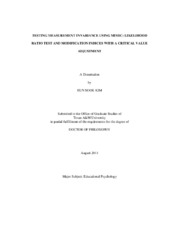| dc.description.abstract | Multiple-indicators multiple-causes (MIMIC) modeling is often employed for measurement invariance testing under the structural equation modeling framework. This Monte Carlo study explored the behaviors of MIMIC as a measurement invariance testing method in different research situations. First, the performance of MIMIC under the factor loading noninvariance conditions was investigated through model fit evaluations and likelihood ratio tests. This study demonstrated that the violation of factor loading invariance was not detected by any of the typically reported model fit indices. Consistently, the likelihood ratio tests for MIMIC models exhibited poor performance in identifying noninvariance in factor loadings. That is, MIMIC was insensitive to the presence of factor loading noninvariance, which implies that factor loading invariance should be examined through other measurement invariance testing techniques.
To control Type I error inflation in detecting the noninvariance of intercepts or thresholds, this simulation study with both continuous and categorical variables employed the likelihood ratio test with two critical value adjustment strategies, Oort adjustment and Bonferroni correction. The simulation results showed that the likelihood ratio test with Oort adjustment not only controlled Type I error rates below the basal Type I error rates but also maintained high power across study conditions. However, it was observed that power to detect the noninvariant variables slightly attenuated with multiple (i.e., two) noninvariant variables in a model.
Given that the modification index is the chi-square difference after relaxing one parameter for estimation, this study investigated modification indices under four research scenarios based on a combination of the cutoffs of modification indices and the procedures of model modification: (a) the noniterative method (i.e., modification indices at the initial stage of model modification) using the conventional critical value, (b) the noniterative method using the Oort adjusted critical value, (c) the iterative procedure of model modification using the conventional critical value, and (d) the iterative procedure using the Oort adjustment. The iterative model search procedure using modification indices showed high performance in detecting noninvariant variables even without critical value adjustment, which indicates that iterative model search specification does not require critical value adjustment in identifying the noninvariance correctly. On the other hand, when the noniterative procedure was used, the Oort adjustment yielded adequate results. | en |


